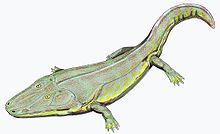Cyclotosaurus
| Cyclotosaurus Temporal range:
| |
|---|---|

| |
| Scientific classification | |
| Domain: | Eukaryota |
| Kingdom: | Animalia |
| Phylum: | Chordata |
| Order: | †Temnospondyli |
| Suborder: | †Stereospondyli |
| Clade: | †Capitosauria |
| Family: | †Mastodonsauridae |
| Genus: | †Cyclotosaurus Fraas, 1889 |
| Type species | |
| †Cyclotosaurus robustus (Meyer & Plienninger, 1844)
| |
| Other species | |
| |
| Synonyms | |
| |
Cyclotosaurus is an extinct
Etymology
The name means "round eared lizard" in Ancient Greek, derived from round openings or fenestrae in the cheeks, which are thought to contain structures of the middle ear.[3]
History

German naturalist Eberhard Fraas erected the genus Cyclotosaurus in 1889, with C. robustus (previously Mastodonsaurus robustus) as the type species.[4] Several species are known, mainly from Germany and Poland in Central Europe, as well as East Greenland and Thailand.[5][6] The relationships between species is unclear.[1]
"Labyrinthodon" pachygnathus Owen, 1842 and "L." leptognathus Owen, 1842 were transferred to Cyclotosaurus, as C. pachygnathus and C. leptognathus, by Paton (1974).[7] However, Damiani (2001) assigned the two species to Mastodonsauroidea indeterminate and Stereospondyli indeterminate.[4]
Palaeontology

The genus is known from the Ladinian in the Middle Triassic to the Norian in the Late Triassic, and represents the last of the Mastodonsaurids.[4]

The oldest, questionable, species is Cyclotosaurus papilio, known from a partial skull recovered from the Ladinian (Middle Triassic) age Upper
Phylogeny
The phylogeny of
Capitosauroidea
|
|
The phylogeny of the genus Cyclotosaurus according to Witzmann et al. (2016).[9]
| Cyclotosaurus |
| |||||||||||||||||||||||||||||||||
See also alternative phylogenies from 2017[2] with the description of C. naraserluki.
Ecology
Cyclotosaurus are thought to have been semi-aquatic carnivores, though feeding strategies likely differed between species.[1]
References
- ^ .
- ^ a b c Marzola, M., Mateus O., Shubin N. H., & Clemmensen L. B. (2017). Cyclotosaurus naraserluki, sp. nov., a new Late Triassic cyclotosaurid (Amphibia, Temnospondyli) from the Fleming Fjord Formation of the Jameson Land Basin (East Greenland). Journal of Vertebrate Paleontology. e1303501., 2017
- ^ Schoch, Rainer (2008). "The Capitosauria (Amphibia): characters, phylogeny, and stratigraphy" (PDF). Palaeodiversity. 1: 189–226.
- ^ .
- ^ Jenkins, F. A. Jr.; Shubin, N. H.; Amaral, W. W.; Gatesy, S. M.; Schaff, C. R.; Clemmensen, L. B.; Downs, W. R.; Davidson, A. R.; Bonde, N.; Osbaeck, F. (1994). "Late Triassic continental vertebrates and depositional environments of the Fleming Fjord Formation, Jameson Land, East Greenland". Meddelelser om Grønland, Geoscience. 32: 1–25.
- ^ .
- ^ PATON, R. L. 1974. Capitosauroid labyrinthodonts from the Trias of England. Palaeontology, 17, 253–289, pls 35–36.
- ^ ISBN 0521458994.
- ^ .
- S2CID 134049099.
External links
- "Tetrapoda". Paleofile. Archived from the original on January 8, 2023.
- "The Norian Age - 3". Palaeos. Archived from the original on April 14, 2009.
- "Cyclotosaurus. Cast of skull". Fossils.valdosta. Archived from the original on November 12, 2016.
- "Taxonomic history of the genus Cyclotosaurus Fraas, 1889". Mikko's Phylogeny Archive. Archived from the original on August 24, 2007.
